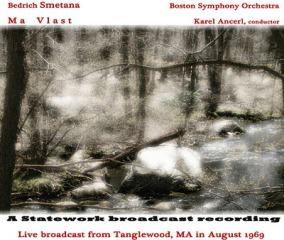Bedrich Smetana – Ma Vlast (Ancerl) [1969]
Bedrich Smetana – Ma Vlast (Ancerl) [1969]

Ma Vlast (My Homeland) 1. Vysehrad (The High Castle) 2. Vltava (Moldau) 3. Sarka 4. Z ceskych luhu a haju (From Bohemian fields and groves) 5. Tabor 6. Blanik Boston Symphony Orchestra Karel Ancerl - conductor August 1969 Live broadcast
Má Vlast is made up of six tone poems all relating to Smetana's beloved Bohemia. The composer was struck deaf early in 1874, just before beginning the first piece in the set, and thus composed the entire work unable to hear a single note of it. Although its individual components are sometimes performed and recorded separately, most commonly the second in the set, The Moldau, the composer intended them as a single entity, to be performed like a suite or symphony. Thus played, the six parts of the work require about 75 minutes. The first, Vysehrad, pertains to a huge, historic rock along the Vltava River, near Prague. It opens with harps intoning a stately theme, the music growing more grandly noble as it proceeds. The mood soon turns somewhat agitated and heroic, before a reprise of the opening closes out Vysehrad.
The next work, Vltava (The Moldau), begins with pairs of swirling flutes and clarinets depicting the two springs feeding the Moldau. Soon the famous main theme, based on the Swedish folk song Ack, Värmland du sköna, is presented. Horns and trumpets introduce a heroic mood to portray the Forest Hunt, which is followed by folk-like music in the "Peasant Wedding." Subdued, nocturnal music permeates "Moonlight: Dance of the Water Nymphs," while "the Rapids" is vigorous and stormy. The river theme returns, but soon gives way to a reprise of the main Vysehrad theme.
Sárka portrays the famous female rebel resentful of male authority, who takes revenge on her unfaithful lover. The tempestuous opening depicts Sárka's anger, while the ensuing march music describes her lover, Ctirad, and his soldier-companions. The lyrical section that follows expresses Ctirad's love for Sárka, while the ensuing festive gaiety enacts the drunken revelry of the soldiers. The dramatic final section brilliantly depicts Sárka's slaughter of Ctirad and his men.
The fourth, Bohemia's Woods and Meadows, opens busily, but as if winding down, the music representing one's arrival in the country. In the ensuing calm, the mood subtly changes from playful to gossamer and mysterious, and then to festive, the last section portraying a peasant festival.
The final two works, Tábor and Blanik, are related both musically and programmatically. The city of Tábor was a fifteenth century Hussite stronghold, and the music here depicts the famous rebellion there. Smetana uses the theme from the Hussite chorale Ye Who Are God's Warriors and fashions a defiant, stirring, often heroic portrait of the ill-fated uprising. In the final piece, the same theme is used, but now to depict the defeated Hussites, who flee to Blanik mountain. There they sleep and eventually aid in the restoration of the Czech nation. The music is mostly pastoral in the first half and colorfully triumphant in the latter portion, especially in the return of the Vysehrad melody. ---Robert Cummings, Rovi
download: uploaded yandex 4shared mediafire solidfiles mega zalivalka filecloudio anonfiles oboom
Last Updated (Monday, 12 May 2014 14:53)








